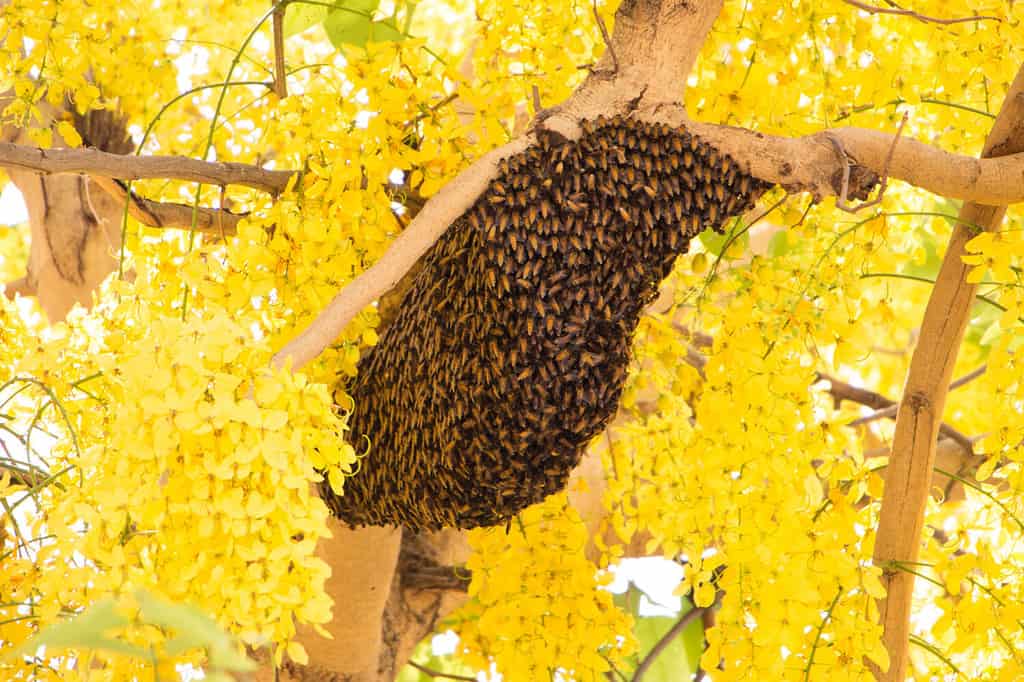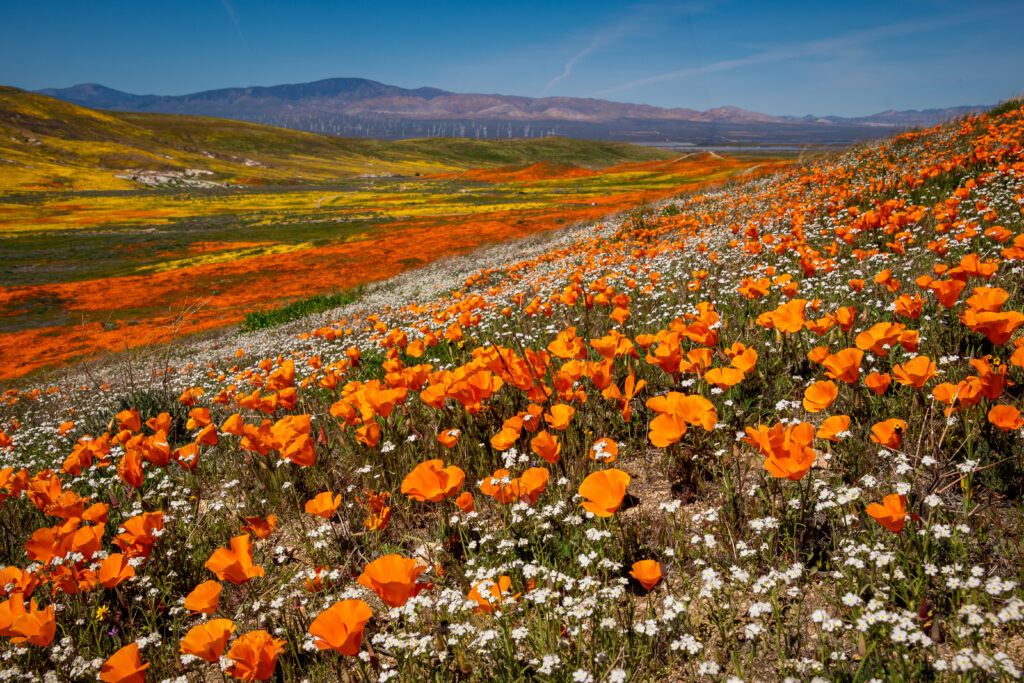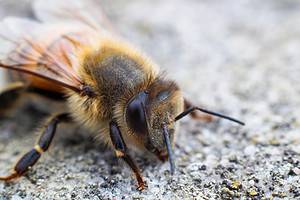Bees have a highly significant role to play in the natural balance, as they are responsible for pollinating innumerable different species of plants, including crops we depend upon for our food supply. But can bees fly at night? We’ll explore this and other bee-related questions in this article, like why some bees are endangered and how you can protect yourself from stings.

Seen up close, the details of a bee’s body are fantastically complex and beautiful.
©iStock.com/arlindo71
Getting to Know Bees
Recognizing Bees
Bees are a large group of insects, with 20,000 known species in the world and 4,000 living in the United States. They range in size from an infinitesimally small 2 millimeters long in a species known as perdita minima, to an Indonesian species known as Wallace’s giant bee that can be 1.5 inches long with a wingspan of 2.5 inches! The ones you’re more likely to see are the common honeybee (.5 inches long) or the bumblebee (.5-1 inch long). Bees usually have orange, yellow, black, or tan stripes, though some species have black or metallic green coloration. In contrast to wasps or hornets, bees are covered with fuzzy hair. Another difference is that bees are herbivorous, feeding on nectar and pollen, while wasps and hornets are carnivores that prey on other insects.
Hive Life
Taking honeybees as an example, bees live together in a hive that revolves around a queen bee. She is larger than the others and is the only female who reproduces, usually making about 1,500 eggs a day. The other females in the hive are worker bees. Young workers stay in the hive to take care of the queen and her larvae. They excrete wax from special glands to build the hive structure of the nest. As they get older, they will start flying out of the nest to collect nectar, pollen, and water. Male bees are called drones and they cannot sting. They have extremely large eyes to help them search for new potential queens to mate with and start new colonies. So where do those queens come from? Worker bees select 10-20 newly hatched larvae to feed a special diet secreted from their heads that activates the new bee’s reproductive system. Once these new queen bees are developed enough, they are driven out of the hive to start colonies of their own.

This swarm of bees is building a new hive.
©Infinity_Pok/Shutterstock.com
Foraging
Most bees, including honeybees, are active during the day. Honeybees tend to be most active in the warmest time of day: early afternoon. Bees are not usually as active early in the morning because it is harder to collect pollen and nectar from dew-covered flowers. So, just what are pollen and nectar? Flowers and other plants attract bees with their color, shape, and nectar, a sweet fluid that bees eat for energy. Pollen is a fine dust-like substance produced for plant reproduction, but it needs to be transferred from one plant to another to make seeds germinate. Bees eat pollen and carry it back to their hive for protein and other nutrients, but it also sticks to their legs and the hairs on their body and gets transferred to other plants. Both pollen and nectar are carried back to the nest as food for the whole colony. Bees pass the nectar from one to another, with each of them absorbing more of the moisture in it until what is left is honey, stored in the cells of the hive. Bees eat stored honey in the winter and at other times nectar and pollen are not available.

Flowers produce pollen, which sticks to bees and gets carried to other flowers.
© 1000 × 667 pixels • 3.3 × 2.2 in • DPI 300 • JPG 500 × 334 pixels • 1.7 × 1.1 in • DPI 300 • JPG Show more Photo Contributor Wirestock Creators Wirestock Creators/Shutterstock.com
Can Bees Fly at Night?
Whether or not bees can fly at night depends on the species. Some bees, especially tropical species, do fly at night because they feed on night-blooming flowers. Honeybees and bumblebees, however, cannot fly at night because they use the rays of the sun to orient themselves during flight. If they do need to move around at night, they do it by crawling. Bees sleep five to eight hours a night, so their schedules are really very similar to those of people.
Why Do Bees Sting, and How Can You Protect Yourself?
In all their foraging, either day or night, bees sometimes cross paths with people, deliberately or accidentally. Not all bees sting, but those that do, react because they are confused, have been stepped on, or feel threatened. Honeybees in particular are very docile, but if they think their hive is under attack, they will defend it vigorously. Honeybees die after stinging, so understandably, it’s not something they like to do.
Preventing Bee Stings:
- Don’t leave uncovered food or drinks out.
- Make sure garbage is sealed in bags and placed in bins with lids.
- Wear light-colored clothing covering as much of your body as you can.
- Don’t make yourself smell like a flower with heavily scented perfumes, hair products, or soaps.
- Enjoy large areas of blooming flowers from a distance, don’t walk in them or spend a long time there.
- Stay still, don’t panic or swat at bees, as this will confuse and agitate them, gently brush them off with an item like a book, phone case, or napkin and walk away from them if they are persistent.
- If you discover a beehive on your property, call the fire department or a beekeeper to remove it.
- Do not kill honeybees. It is not illegal to do so, but it is poor environmental stewardship. A hive of honeybees can cost $2,000. A beekeeper will gladly remove honeybees from your property to their farm for honey production.
Treating Bee Stings
- If you are stung, ask someone to stay with you in case you have an allergic reaction.
- Rinse the sting with soap and water.
- If the stinger is still in your skin, remove it by scraping a clean fingernail over the sting or wiping it with a clean piece of gauze.
- So not squeeze the stinger or use tweezers, as this could force more venom into the sting.
- Reduce swelling with an ice pack.
- Do not scratch the sting because that could increase swelling, make it itch more, and cause infection.
Signs of Allergic Reaction
Only 5-7.5 % of Americans are hypersensitive to bee stings. But if you experience any of these symptoms after a sting, you may be allergic. If so, the chance of severe allergic reactions may increase each time you are stung. Use an epinephrine auto-injector if you have one and call 911.
- Hives, itching, and flushed or pale skin.
- Swelling of the throat and tongue, difficulty breathing.
- Weak and rapid pulse.
- Nausea, vomiting, diarrhea.
- Dizziness, fainting, loss of consciousness.

Localized pain, redness, itching, and swelling are normal with a bee sting.
©kanoksak neamsum/Shutterstock.com
Bees and the Environment
Bees are extraordinarily important in the environment. About 80% of the pollination of flowering plants depends on bees and other pollinators. Without them, many plant species would not be able to reproduce effectively. This would impact plants that are necessary as food for wild animals as well as groundcover that helps prevent soil erosion. Bees pollinate support the crops of about 35% of all the agricultural land in the world, which is essential to our food supply and many of the plant-based raw materials we use in manufacturing and even the production of some kinds of medicines.
It is very concerning that 40% of all bee species are in danger of extinction, including the American bumblebee, whose numbers have declined 89%. Bumblebees are already extinct in eight states and in sharp decline in many others. Beekeepers in recent years have been recording declines of 50% a year in hive populations. There are a lot of different factors threatening bees: overuse of pesticides, conversion of farmland to residential and commercial use, and problems like mites and fungi. Large-scale industrial farming involves planting huge fields in a single crop, which reduces biodiversity, supports less of a variety of pollinators, and removes trees and brush where bees could build hives. Global warming is also creating chaotic weather, including droughts and floods, and is changing the blooming seasons of flowering plants, all of which gives bees a less reliable food source.

Large-scale industrial agriculture reduces the biodiversity and removes potential nesting sites.
©Fotokostic/Shutterstock.com
How Can You Attract More Bees?
Understanding the importance of bees may make you want to attract more to your property. If so, here are some things you can do to make your yard more bee-friendly:
- Plant flowers with flat blooms, like daisies, zinnias, and asters.
- Select a combination of plants that will bloom continuously through different seasons of the year.
- Choose plants with blossoms of different shapes and colors. Bees like blue, white, yellow, and purple.
- Plant flowers in clumps to make them easier for bees to spot.
- Provide a water source like a birdbath or sprinklers.
- Naturalize parts of your lawn with beds of wildflowers and grasses. It’s better for the bees and less lawn maintenance for you. Native plants often produce more pollen and nectar than hybridized ones.
- Put up a bee box, available at hardware stores, just as you might put up birdhouses or bat houses.
- Use organic-approved pesticides, non-toxic insecticides, or pest barriers.

There’s a simple and beautiful solution to the problem of endangered bees: plant more flowers!
©MierCat Photography/Shutterstock.com
Bees and flowers are both fragile but unbelievably complex, like the environment itself. The more we learn about the smallest beings in the ecosystem, the more we learn how important each one is.
The photo featured at the top of this post is © HWall/Shutterstock.com
Thank you for reading! Have some feedback for us? Contact the AZ Animals editorial team.






